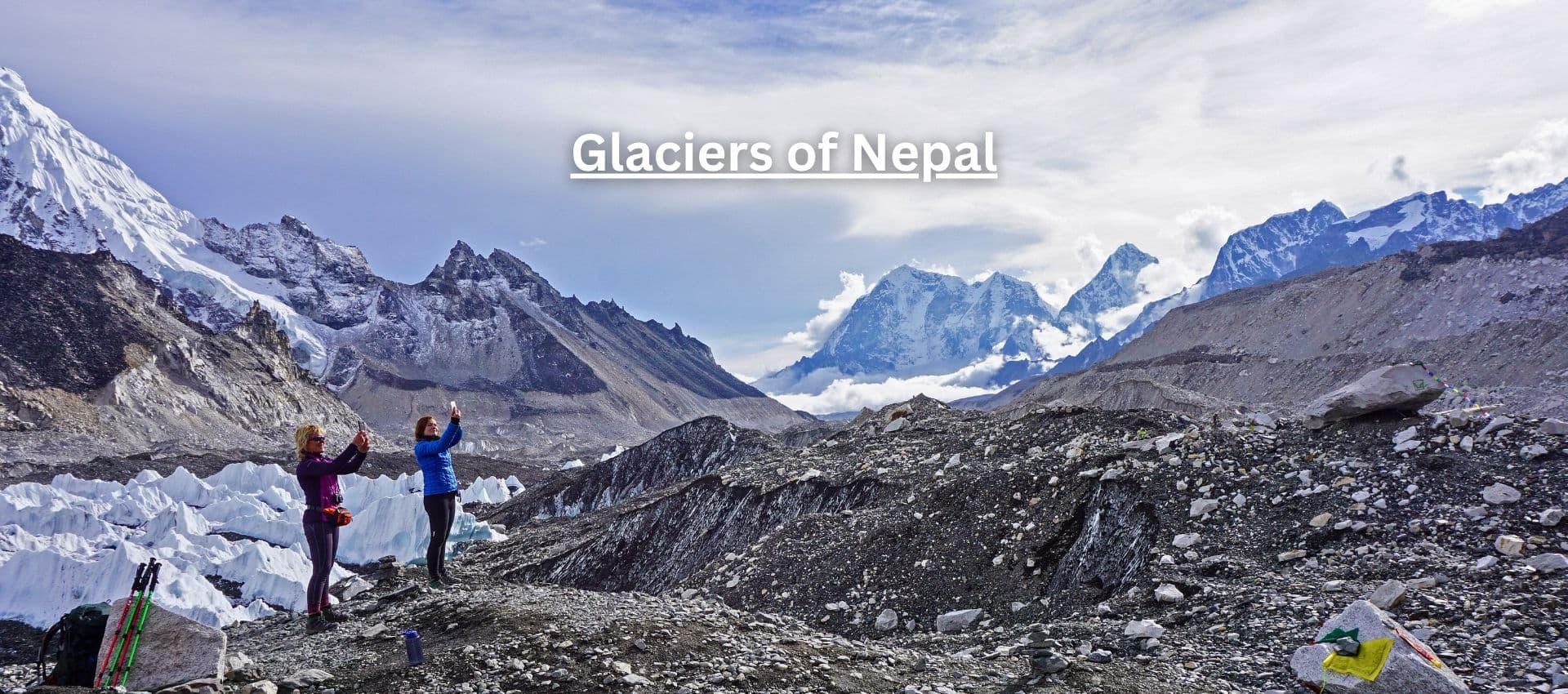- Top 12 List of Glaciers in Nepal
- Khumbu Glacier: The glacier at the top of the world
- Ngozumpa Glacier: The longest glacier in the Himalayas
- Imja Glacier: The glacier at the foot of Island Peak
- Amphulabtsa Glacier: A natural marvel
- Lhotse Shar Glacier: Under the shadow of the Himalayan giants
- Langtang Glacier: At the Valley of Glaciers
- Yala Glacier: A glacier that will disappear by 2040 AD
- Annapurna Glacier System: The star of the sacred Annapurna Sanctuary
- Gangapurna Glacier: Flowing down Mount Gangapurna
- Tilicho Glacier: A sacred destination on the Annapurna Circuit
- Barun Glacier: The snowy jewel of the Makalu-Barun National Park
- Tarkarding Glacier: The glacier that feeds the Tsho Rolpa Lake
Nepal’s natural wealth is its mountains, glaciers, forests, and rivers. With thirty-five percent of the country’s landmass covered by the Himalayan Range, Nepal is home to the central-eastern portion of the Himalayan Mountain range, which includes eight of the world's 14 peaks over 8,000 meters, including the tallest mountain in the world, Mount Everest. At the base of these mountains lie the massive glaciers which store a significant amount of freshwater, regulate climate, sustain human and animal life and shape valleys.
The glaciers in Nepal are a lifeline to the country’s ecosystem, as the meltwater from the glaciers feeds the rivers, which are an important source for drinking water, hydropower, and farming. Originating at the base of massive snow-covered mountains, these glaciers also serve as attractions for trekkers and climbers exploring the mountains and foothills of Nepal. Glaciers in Nepal also provide scientists with valuable data about life in the past. The icy glaciers hold the soil together and prevent erosion, thus stabilizing mountain slopes and preventing dangerous landslides and rockfall.
If you wish to know more about the glaciers in Nepal, dive in. Here we feature a list of Nepal’s twelve major glaciers, which make up some of the important sources of river systems in South Asia.
Top 12 List of Glaciers in Nepal
Khumbu Glacier: The glacier at the top of the world
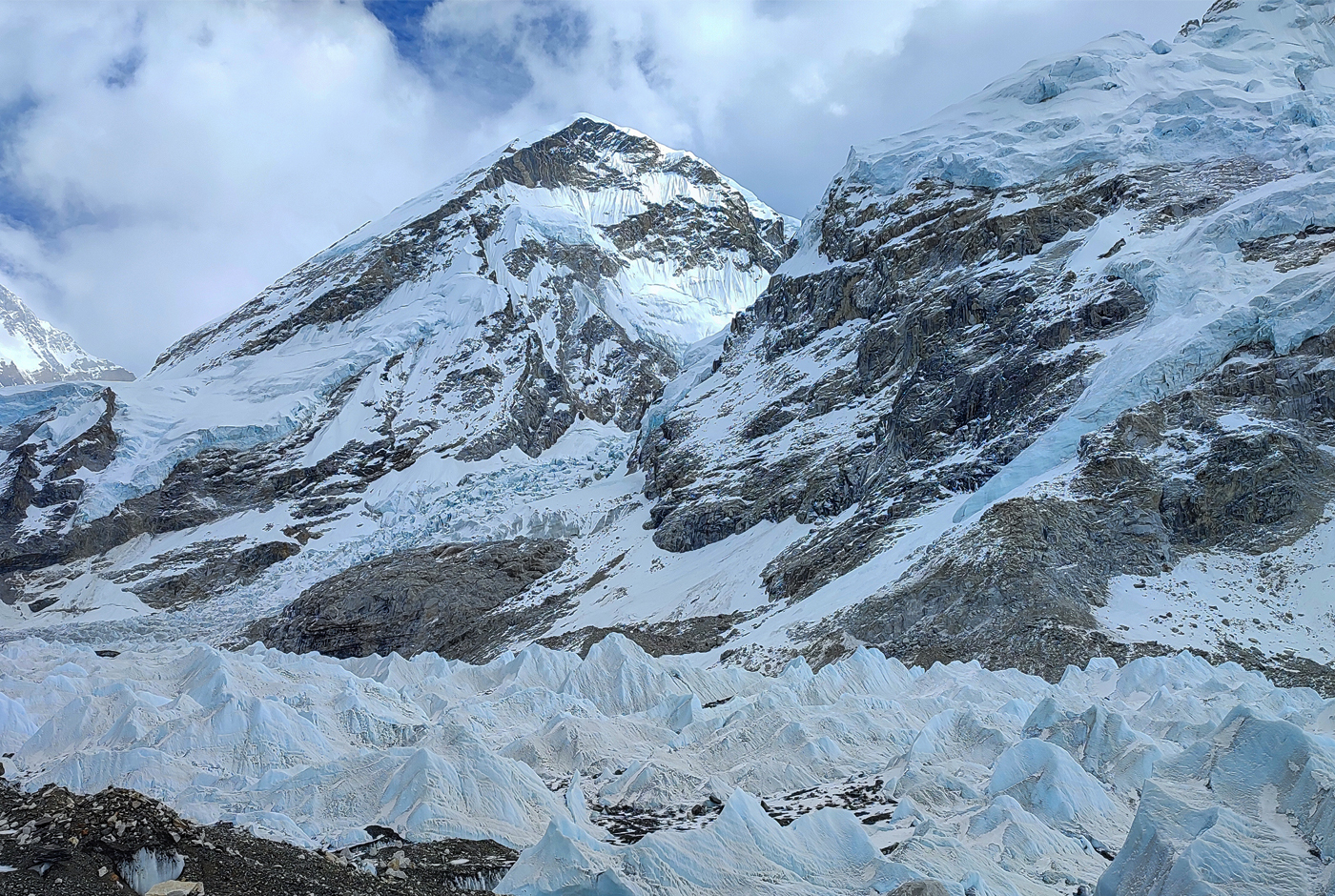
The Khumbu Glacier lies almost at the top of the world, at the base of Mount Everest, Lhotse, and Nuptse. It originates at an altitude of 7900 m, which makes it the world’s highest glacier. Located within the Sagarmatha National Park in the Khumbu Region, the Khumbu Glacier sustains the high-altitude ecosystem of the Everest region, supporting both vegetation and wildlife. This glacier is a major freshwater reservoir that provides meltwater for rivers flowing in the region, which the local Sherpa communities depend on for drinking water, agriculture, and livestock.
The Khumbu Glacier serves as a key route to climb Mount Everest. It is in fact the primary and most hazardous route for climbers ascending Mount Everest via the South Face route, especially the dangerous Khumbu Icefall section. The trekking route to Everest Base Camp also winds alongside this amazing glacier. While the terminal point of the glacier lay much further in the earlier decades, the glacier has been slowly receding and becoming thinner due to climate change. Scientists have estimated that the Khumbu Glacier, on average, recedes thirty meters every year. This is a cause of concern for the local communities, climbers, and trekkers, as the glaciers retreat will lead to an unstable and hazardous environment. The shrinking of the Khumbu Glacier will also affect millions of people, as it is a major freshwater reservoir, providing meltwater that feeds the Dudh Koshi River system, which supports millions of people living downstream in Nepal and eastern India.
Ngozumpa Glacier: The longest glacier in the Himalayas

Another giant glacier in the Khumbu or the Everest region is the Ngozumpa Glacier. The glacier originates at the base of the Cho Oyu, the sixth-highest mountain in the world. It stretches for thirty-six kilometers, which makes it the longest glacier in the Himalayas. The Ngozumpa Glacier begins from the base of Cho Oyu, tumbles down to the Gokyo Valley and terminates at the picturesque Gokyo Village.
The meltwater from the Ngozumpa Glacier feeds the six Gokyo lakes, which are the highest freshwater-lake system in the world. The lower section of the Ngozumpa Glacier is covered by rocks and debris, giving it a gray appearance. Trekkers visiting the Gokyo Lakes and walking along the Gokyo Valley can witness this marvelous glacier.
Imja Glacier: The glacier at the foot of Island Peak
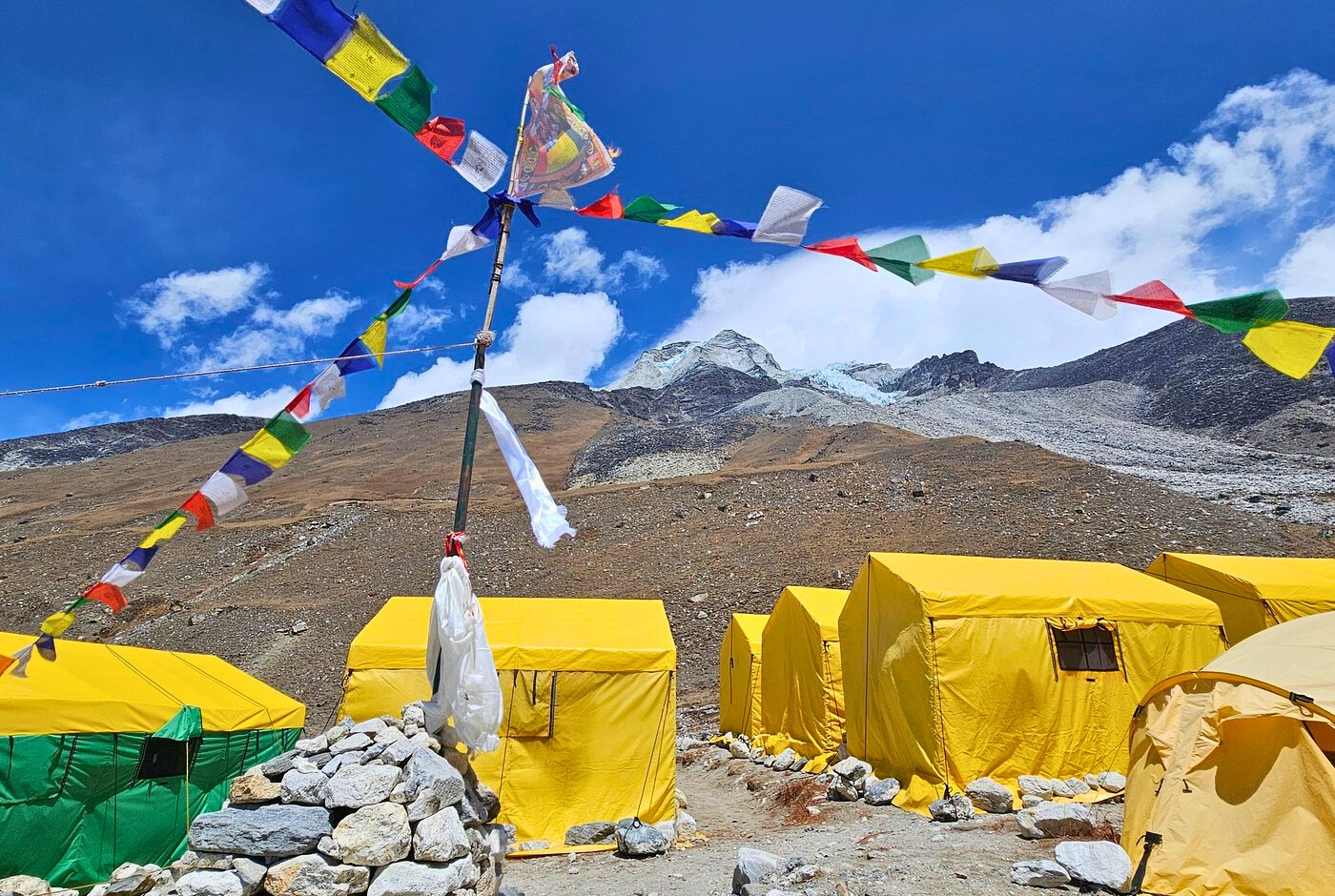
The Imja Glacier is one of the most dramatic glaciers in the Khumbu Region. Originating at the base of Imja Tse or Island Peak, the meltwater from the glacier feeds the Imja Lake and Imja River.
Scientists have been studying the rapid retreat of the Imja Glacier and the subsequent expansion of the Imja Lake since the 1960s. The shrinking of the glacier has provided visible and well-documented evidence of global warming and its impact on high-altitude environments. This makes the glacier a critical site for scientific study of glacier-climate interactions. The well-documented history of the Imja Glacier's changes has made it one of the most extensively studied lakes in the Himalayas, serving as a case study for evaluating GLOF(glacial lake outburst flood) risk, developing early warning systems, and understanding the dynamics of glacier retreat.
Climbers who attempt to scale the Island Peak, one of the most popular peaks for mountaineers in Nepal, traverse this majestic glacier. The Imja Glacier can also be viewed from the Sherpa village of Chukkung.
Amphulabtsa Glacier: A natural marvel
The Amphulabtsa Glacier lies in the Khumbu Region close to the Imja Glacier and the Lhotse Shar Glacier. This beautiful glacier is covered in serac cliffs and is part of the Amphu Laptsa Pass trekking route. The glacier’s meltwater feeds the pristine Amphulabtsa Tsho Glacial Lake. Not as massive as some of the glaciers mentioned in this list, the Amphulabtsa Glacier is, however, known to offer an amazing challenge for trekkers and climbers.
The area is a destination for experienced mountaineers and trekkers, as crossing the pass is considered one of the most difficult and technical adventures in the Himalayas, often requiring the use of ropes, crampons, and ice axes. Treks leading to the Mera Peak and the Hinku and the Honku Valleys often involve crossing this picturesque pass.
Lhotse Shar Glacier: Under the shadow of the Himalayan giants
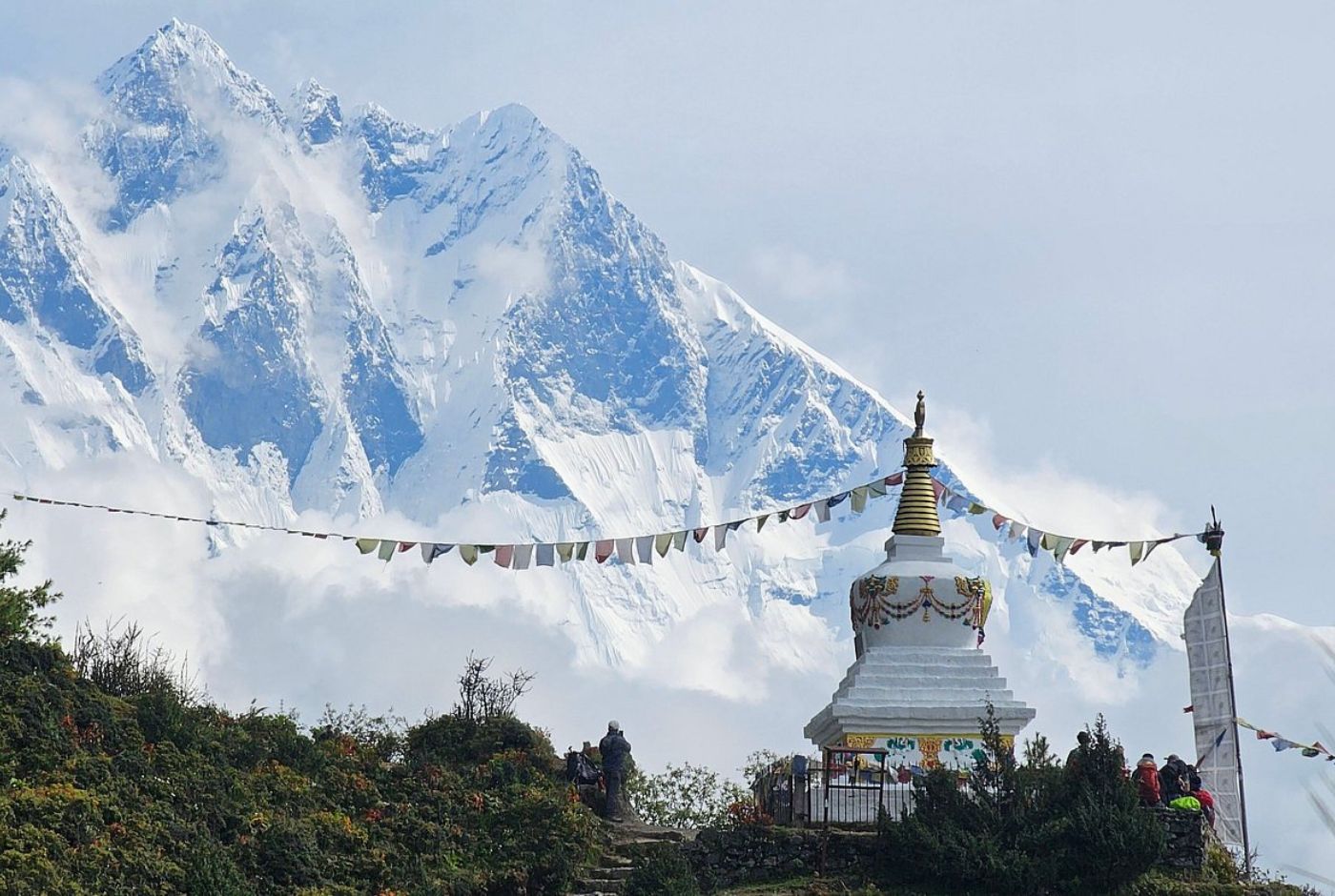
The Lhotse Shar Glacier lies in the Solukhumbu Region near the Lhotse massif, which includes the main Lhotse peak (fourth-highest mountain in the world) and its subsidiary peaks, Lhotse Middle and Lhotse Shar. The Lhotse Shar Glacier is the largest source of meltwater feeding the Imja Tsho glacial lake, which in turn contributes to downstream river systems. The glacier and surrounding area have been the site of numerous mountaineering expeditions, serving as an approach for various climbing routes on Lhotse and nearby peaks like Imja Tse (Island Peak).
The Lhotse Shar Glacier, like other glaciers in the region, is also rapidly shrinking. The changes observed in the Lhotse Shar Glacier and the rapid growth of Imja Tsho Lake have made the area a critical case study for understanding how Himalayan glaciers respond to global warming and the associated climate drivers.
Langtang Glacier: At the Valley of Glaciers

The Langtang Glacier is one of the major glaciers in the Langtang Region. This beautiful glacier originates at the Langtang Lirung Peak and stretches for 18 kilometers, feeding glacial lakes and the Langtang River. It is the longest glacier in the region and a major attraction for tourists trekking and climbing in this region. One can enjoy an excellent view of the Langtang Glacier while hiking to Kyangjin Ri, one of the main highlights of the Langtang Valley Trek.
The Langtang Glacier covers an area of 46.5 square kilometers and extends between altitudes of 4500 meters and 7000 meters. It lies within the Langtang National Park which is home to rare Himalayan flora and fauna and ancient Tamang villages. Like other major glaciers in the Himalayas, the Langtang Glacier is also shrinking due to global warming.
Yala Glacier: A glacier that will disappear by 2040 AD
The Yala Glacier is located within the Langtang National Park, close to Tibet. It lies surrounded by the mighty spires of Lantang Lirung, Gangchhenpo, and Yala Peak. The Yala Glacier extends from an altitude of 5750 tmeters o 5170 meters above sea level. It remains one of the most studied glaciers in the Hindu Kush Himalayan region, where scientists have been monitoring its significant retreat since 1974. The region’s proximity to Kathmandu has made Yala Glacier an ideal and accessible location for scientific research, where data on mass balance and ice loss is collected to better understand glacial retreat.
The speed at which the Yala Glacier is melting has led scientists to suggest it may vanish by the 2040s. In May 2025, a symbolic funeral was held to highlight the "dying" state of the glacier and the broader impact of climate change. Two granite plaques were unveiled, acknowledging the urgent need for action to mitigate the effects of climate change.
One can traverse the Yala Glacier while climbing Yala Peak, a great peak for novice climbers.
Annapurna Glacier System: The star of the sacred Annapurna Sanctuary

The Annapurna Glacier System lies within the protected Annapurna Conservation Area. It is nestled beneath the mighty and sacred Annapurna Massif, which includes the world’s tenth-highest mountain, Annapurna I, and its sister peaks, Annapurna II, Annapurna III, and Gangapurna. The Annapurna Glacier System is responsible for shaping the landscape surrounding these mountains and for feeding the major river systems within central Nepal, like the Modi Khola and the Marshyangdi River. The meltwater from the glacier system has formed numerous glacial lakes, including the world's lowest-altitude glacial lake, Kapuche Glacier Lake at 2546 meters.
The Annapurna Glacier System can be seen in all its glory at the Annapurna Sanctuary, a glacial basin located close to the Annapurna Base Camp. From the viewpoint, you can witness the glaciers and also listen to the ‘voice of the glaciers’ (a cracking and groaning sound made by the glaciers as they move and melt constantly). To watch this natural marvel of nature, you can undertake the Annapurna Base Camp Trek, one of the most loved Himalayan treks in Nepal.
Gangapurna Glacier: Flowing down Mount Gangapurna
The Gangapurna Glacier is an important ice formation in the Annapurna Range, which descends from the snowy slopes of Mount Gangapurna. The glacier's meltwater accumulates to form the picturesque, turquoise-blue Gangapurna Lake at an altitude of around 3,540 meters (11,600 feet). The lake itself is a relatively recent formation, having appeared around the 1960s as the glacier retreated.
Both the Gangapurna Glacier and the lake are major natural attractions for trekkers, providing breathtaking views and serving as a key water source for the Marshyangdi River and local streams. Trekkers on the Annapurna Circuit often take a day hike to the glacier viewpoint from the Manang Valley as an acclimatization activity.
Like many mountain glaciers, the Gangapurna Glacier is also highly vulnerable to rising global temperatures and has been rapidly shrinking. Its retreat has led to the expansion of Gangapurna Lake and raised concerns about potential glacial lake outburst floods (GLOFs) in the valley below.
Tilicho Glacier: A sacred destination on the Annapurna Circuit
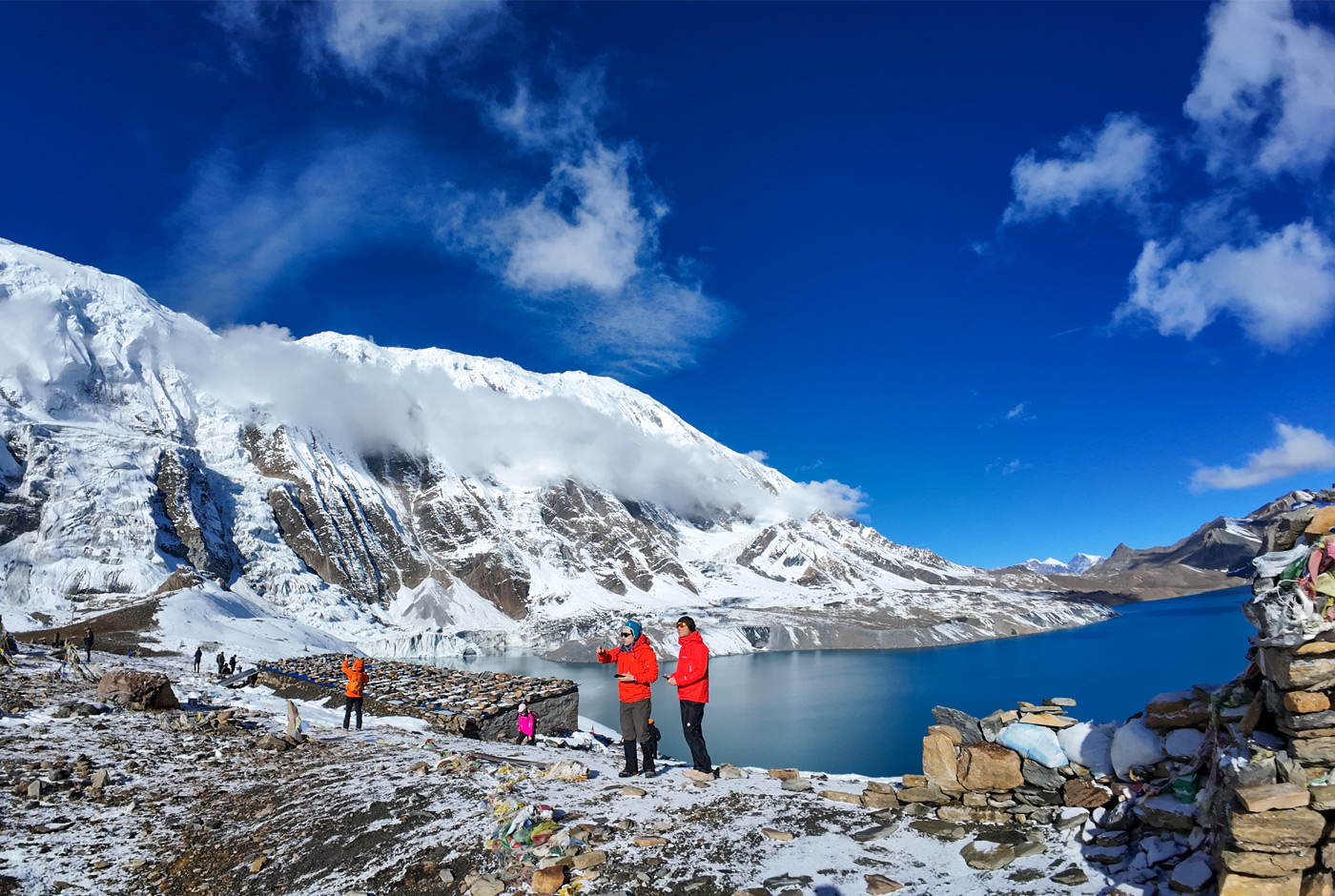
The Tilicho Glacier lies beneath the Tilicho Peak, a 7000-meter peak in the Annapurna Region. Located in the Manang District, within the Annapurna Conservation Area, the Tilicho Glacier feeds the sacred and pristine Tilicho Lake, a pilgrimage site and a popular attraction on the Annapurna Circuit trekking route.
Tilicho Lake has religious significance for both Hindus and Buddhists, who consider it sacred and a place for pilgrimage and spiritual cleansing. Hindus identify it with the ancient Kak Bhusundi Lake mentioned in the Ramayana, where the sage Kak Bhusundi is said to have first recited the epic. Buddhists revere it as a site where Milarepa meditated. For followers of both faiths, the lake's high-altitude, remote location is a sanctuary for prayer and connection with the divine. Some Tibetan Buddhist and Bon practitioners view the lake as home to mountain spirits and a place where monks and hermits meditate to connect with the spiritual world.
In order to visit the Tilicho Glacier, one can do the Annapurna Circuit Trek and take a short excursion to the Tilicho Lake from Khangsar or Manang Village. The trek to the Tilicho Lake and glacier is generally considered moderately difficult due to the high altitude and rugged, landslide-prone terrain. Both the glacier and the lake lie surrounded by dramatic mountain scenery, including Annapurna II, Annapurna III, Gangapurna, and Tilicho Peak. Proper acclimatization is recommended to avoid altitude sickness while heading towards the lake.
Barun Glacier: The snowy jewel of the Makalu-Barun National Park
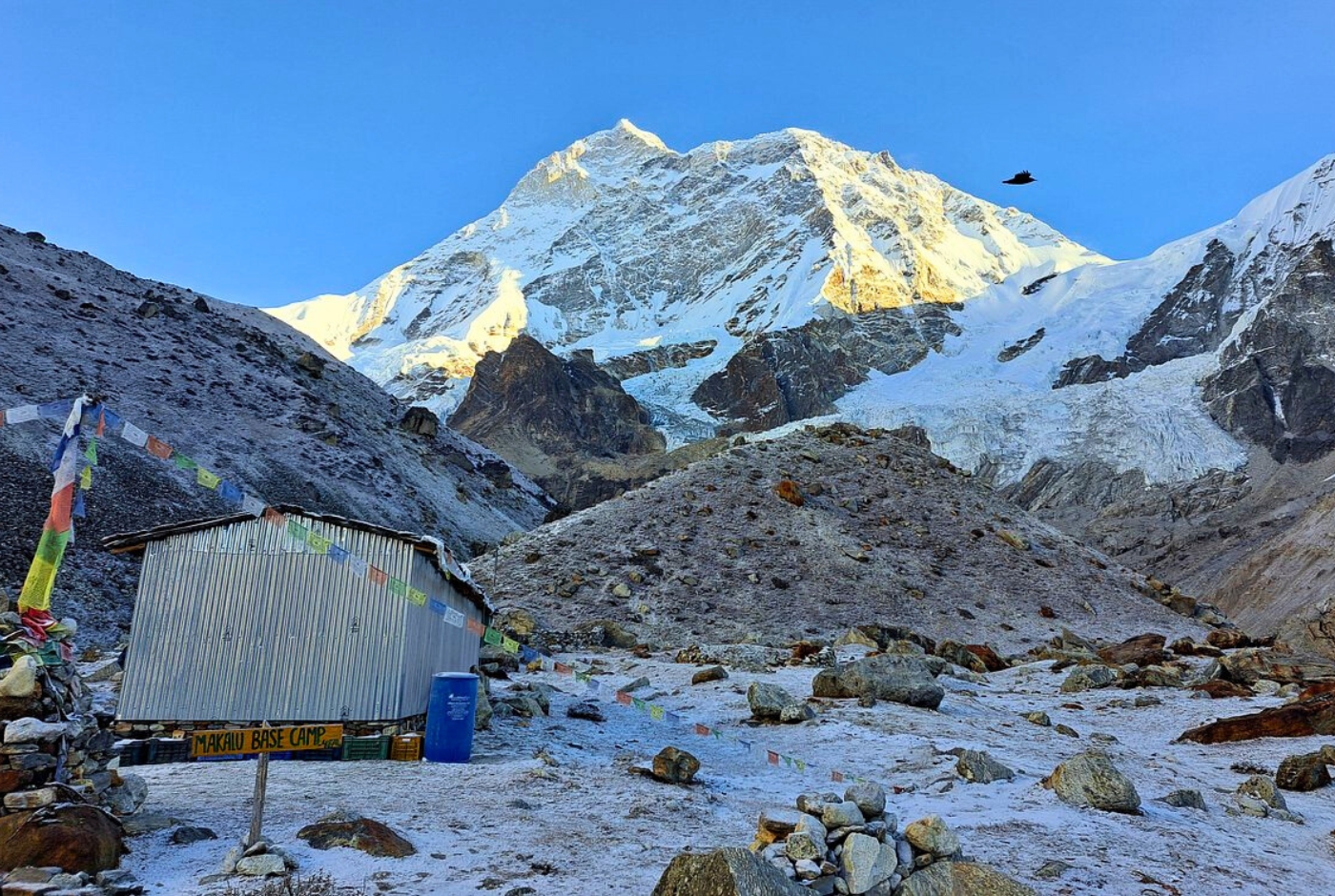
The Barun Glacier is situated in eastern Nepal within the Makalu-Barun National Park, a unique protected area encompassing a vast range of elevation from tropical forests to snow-capped peaks. The area is known for its diverse wildlife and largely untouched natural scenery.
The Barun Glacier lies at the foot of Barun Tse, a 7129-meter peak in the Mahalangur Ridge, close to Mount Makalu, the world's fifth-highest mountain. Meltwater from the Barun Glacier forms the Barun River, which flows through the picturesque and remote Barun Valley. This river is a tributary of the Arun River, a mighty river in eastern Nepal.
The Barun Glacier also feeds several glacial lakes, including the Lower Barun Glacial Lake and the Upper Barun Lake. The Lower Barun Lake, which sits at an elevation of around 4,550 meters, is considered the deepest and most voluminous glacial lake in the Nepal Himalayas. This lake is growing rapidly due to the high rate of melting of the Barun glacier.
The Barun Glacier and the glacial lakes formed by the melting of the glacier can be clearly viewed from the Makalu Base Camp, the destination for trekkers on the adventurous Makalu Base Camp Trek.
Tarkarding Glacier: The glacier that feeds the Tsho Rolpa Lake
The Tarkarding Glacier is located in the Rolwaling Valley inside the Gaurishankar Conservation Area, a protected region in the Himalayas known for its diverse ecosystems, rich culture, and the sacred Gaurishankar Himal peak. The glacier originates from a huge snow bed and high-altitude snow accumulation, particularly from the steep eastern headwall of the valley.
Extending from elevations of 4,500 to 6,690 meters above sea level, the Tarkarding glacier feeds the Tsho Rolpa Lake, one of the largest glacial lakes in Nepal. The glacier has been rapidly retreating at a rate of sixty meters per year, resulting in a continuous supply of meltwater. Thus, the beautiful Tsho Rolpa Lake has been rapidly expanding due to the shrinking of the Tarkarding glacier, adding to the risk of the lake’s outburst and flooding. The receding glacier and the expanding Tsho Rolpa are posing a great threat to communities living in the lower Rolwaling and Tama Koshi Valleys.
The Tarkarding Glacier and the Trambau Glacier were part of a glacier system. However, due to global warming, the ice cover connecting the two glaciers has melted, leading to a disconnect between the two glaciers.
In order to witness the Tarkarding Glacier and the great Tsho Rolpa Lake, you can book the Tsho Rolpa Trek and head to the Rolwaling Valley.
Effects of Climate Change: How is it impacting Nepal?
While Nepal's contribution to global climate change is considered negligible, accounting for approximately 0.027% of total global greenhouse gas emissions, it ranks fourth globally in terms of vulnerability to climate change.
In recent years, Nepal has been at the receiving end of climate change. The country has experienced more frequent and intense water-related disasters such as river floods, landslides, and glacial lake outburst floods (GLOFs). Extreme rainfall events have become more common in the country, with recent studies showing that human-induced climate change has made extreme weather events more likely. These events destroy homes, infrastructure, and farmland, displacing thousands.
The climate crisis in Nepal is fundamentally a water crisis, affecting food security, energy security (through damage to hydropower projects), health, and poverty alleviation. The agricultural sector, on which much of the population depends, is severely impacted by erratic rainfall and unpredictable seasons. A majority of crop losses in Nepal are climate-induced, leading to reduced incomes, food shortages, and increased poverty, often forcing migration.
Rising temperatures are causing snow cover depletion and glacier retreat in the Himalayas, leading to higher water stress in some regions and increased erosion in others. There are also negative health impacts, including an increase in waterborne diseases.
The Retreating Himalayan Glaciers: Why should you experience the glaciers now?
It is a sad fact that in a couple of decades, most of the glaciers will vanish completely due to climate change. With the change in climate patterns, the snow and ice cover on Nepal’s Himalayan mountains is slowly disappearing. On the fluted and forked spires of the Fishtail Peak and the Ama Dablam, the white snow is slowly disappearing, revealing the gray rockface. Dirt and debris cover the once frozen, pristine white glaciers.
If you wish to witness the beauty and majesty of the Himalayan glaciers, there’s no better time than now. Book your trek and head to the Himalayas as soon as you can make it, because those glaciers will no longer be there to fill you with awe and wonder a couple of years down the line.
Walk with the Nepal Hiking Team and experience the best trekking in Nepal. With our team, you can experience the natural wonders of the Himalayan landscape, including glaciers and glacial lakes. Trek to Everest Base Camp and experience the magnificent beauty of the Khumbu Glacier and the Khumbu Icefall. Walk along the Annapurna Circuit and visit the magnificent Tilicho Glacier and the sacred Tilicho Lake. If you are a budding climber, then you can book an expedition to Island Peak and Mera Peak and experience the incredible Imja Glacier and the Amphulabtsa Glacier. If you have only a week to spare, then you can trek to the Langtang Valley and enjoy the awe-inspiring views of the valley of glaciers, including the Langtang Glacier. You can visit the Annapurna Base Camp to get a glimpse of the Annapurna Glacier System and listen to the ‘voice of glaciers,’ a symphony of cracking and groaning sounds made by the glaciers as they melt and shift.
Final Note
Nepal’s numerous mountain glaciers are important freshwater reservoirs for local communities and the ecosystem as a whole. Without these glaciers, life would be difficult, as the freshwater supply would dry up, leaving the rivers parched and empty. A big concern is global warming, which is accelerating the changes in the climate patterns and slowly making the glaciers recede. While some of the first-world countries refuse to acknowledge that climate change is real, the receding Himalayan glaciers are undeniable proof of global warming.
The glaciers in the Himalayan regions of Nepal have provided sustenance to not only people living in Nepal but also to a larger South Asian population, which depends on the river systems and tributaries flowing down from the Himalayas to their regions. It is high time for each of us to think seriously about saving our glaciers and our environment. While we cannot reverse climate change, we can at least make responsible choices (pro-environment and sustainable choices) in our everyday lives to save our planet and our glaciers.
